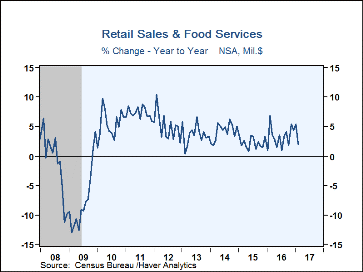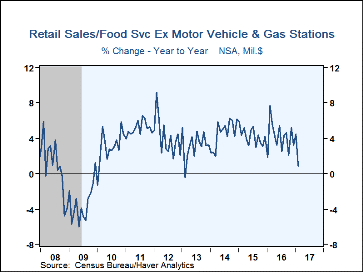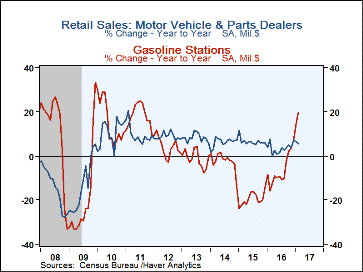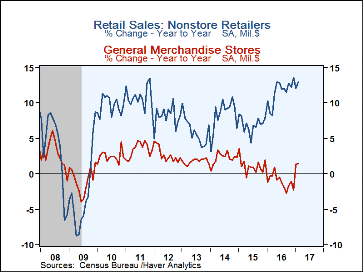 Global| Mar 15 2017
Global| Mar 15 2017U.S. Retail Sales Moderate as Non-Auto Spending Tapers
Summary
Total retail sales and spending at restaurants rose 0.1% (5.7% y/y) in February following a 0.6% increase in January, which was revised up from 0.4%. The February result was in line with the 0.1% increase expected in the Action [...]
Total retail sales and spending at restaurants rose 0.1% (5.7% y/y) in February following a 0.6% increase in January, which was revised up from 0.4%. The February result was in line with the 0.1% increase expected in the Action Economics Forecast Survey.
Sales at motor vehicles & parts dealers decreased again in February, by 0.2% (5.6% y/y), following January's 1.3% decline. This corresponded to a similar February decrease of 0.2% in unit sales of light vehicles. Excluding autos, retail sales rose 0.2% (5.7% y/y) after January's 1.2% gain; this latest result was also in line with the Action Economics consensus forecast. Sales at gasoline service stations fell, along with gasoline prices; sales were down 0.6% (19.6% y/y) as the February CPI for gasoline dropped 3.0%. Those sales had risen 2.1% in January. Retail sales excluding both auto dealers & gas stations were up 0.2% (4.2% y/y) in February following a 1.0% January rise.
In nonauto discretionary spending categories, furniture store sales rose 0.7% (4.9% y/y) after January's 2.4% increase. Several other store groups that had had January gains after a slow December turned slower again or had outright declines in February; electronics & appliance store sales, which had rebounded from a 1.1% fall in December to a 1.1% gain in January, then dropped 2.8% (-6.0% y/y) in February. Clothing store sales fell in February by 0.5% (1.6% y/y) after a January rise of 1.2%. General merchandise store sales were down 0.2% (1.5% y/y) following a 1.5% increase. Sporting goods store sales were off 0.4% (-3.6% y/y) after January's 1.4% rise.
In the non-discretionary spending categories, health & personal care store sales increased 0.7% (7.0% y/y) in January, just a bit slower than January's 0.9% rise. Food & beverage store sales were flat in February (2.2% y/y) after January's 0.4% rise.
Nonstore retailers' sales were up 1.2% (13.0% y/y), following January's 0.5% increase. These include online shopping and mail order outlets; they represent about 10.5% of total retail sales.
Sales at food service & drinking places eased 0.1% in February (3.7% y/y) after January's sizable 1.7% advance.
The retail sales data can be found in Haver's USECON database. The Action Economics forecast expectations are included in the AS1REPNA database.
| Retail Spending (%) | Feb | Jan | Dec | Feb Y/Y | 2016 | 2015 | 2014 |
|---|---|---|---|---|---|---|---|
| Total Retail Sales & Food Services | 0.1 | 0.6 | 1.0 | 5.7 | 3.3 | 2.3 | 4.2 |
| Excluding Autos | 0.2 | 1.2 | 0.4 | 5.7 | 3.1 | 1.2 | 3.7 |
| Non-Auto Less Gasoline | 0.2 | 1.0 | 0.3 | 4.2 | 4.2 | 4.2 | 4.6 |
| Retail Sales | 0.1 | 0.5 | 1.3 | 5.9 | 2.9 | 1.6 | 4.0 |
| Motor Vehicle & Parts | -0.2 | -1.3 | 3.1 | 5.6 | 3.9 | 6.5 | 6.5 |
| Retail Less Autos | 0.2 | 1.1 | 0.7 | 6.0 | 2.6 | 0.2 | 3.3 |
| Gasoline Stations | -0.6 | 2.1 | 3.0 | 19.6 | -6.2 | -19.2 | -2.3 |
| Food Service & Drinking Places Sales | -0.1 | 1.7 | -1.0 | 3.7 | 5.9 | 8.1 | 6.1 |
Carol Stone, CBE
AuthorMore in Author Profile »Carol Stone, CBE came to Haver Analytics in 2003 following more than 35 years as a financial market economist at major Wall Street financial institutions, most especially Merrill Lynch and Nomura Securities. She has broad experience in analysis and forecasting of flow-of-funds accounts, the federal budget and Federal Reserve operations. At Nomura Securites, among other duties, she developed various indicator forecasting tools and edited a daily global publication produced in London and New York for readers in Tokyo. At Haver Analytics, Carol is a member of the Research Department, aiding database managers with research and documentation efforts, as well as posting commentary on select economic reports. In addition, she conducts Ways-of-the-World, a blog on economic issues for an Episcopal-Church-affiliated website, The Geranium Farm. During her career, Carol served as an officer of the Money Marketeers and the Downtown Economists Club. She has a PhD from NYU's Stern School of Business. She lives in Brooklyn, New York, and has a weekend home on Long Island.









